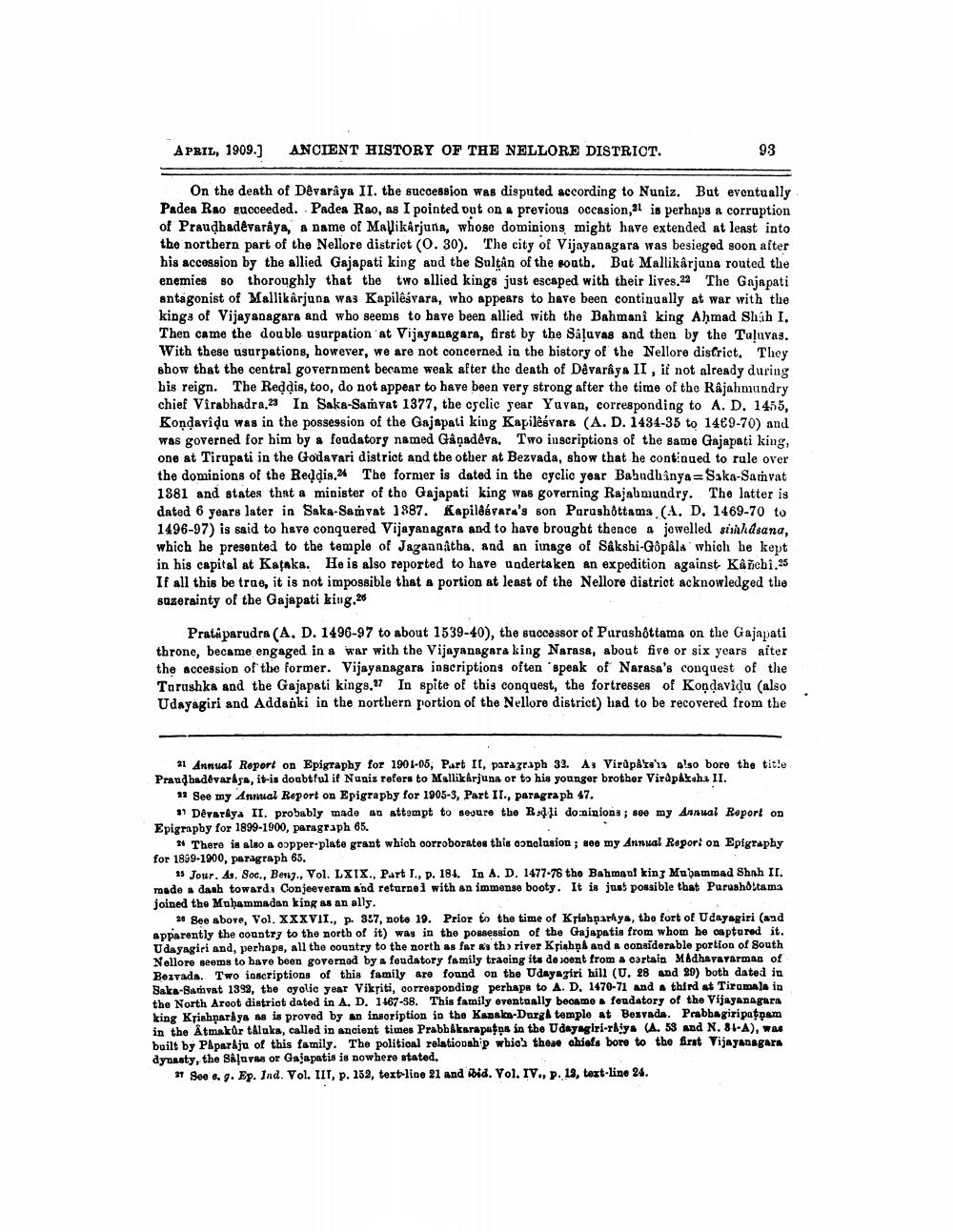________________
APRIL, 1909.)
ANCIENT HISTORY OF THE NELLORE DISTRICT.
93
On the death of Dêvarîya II. the succession was disputed according to Nuniz. But eventually Padea Rao succeeded. Padea Rao, as I pointed out on a previous occasion, 31 is perhaps a corruption of Praudhadêvarêya, a name of Mallikarjuna, whose dominiong might have extended at least into the northern part of the Nellore district (0.30). The city of Vijayanagara was besieged soon after his accession by the allied Gajapati king and the Sultan of the south. But Mallikarjuna routed the enemies 80 thoroughly that the two allied kings just escaped with their lives.22 The Gajapati antagonist of Mallikarjuna waz Kapilêsvara, who appears to have been continually at war with the kings of Vijayanagara and who seems to bave been allied with the Bahmani king Ahmad Shah I. Then came the double usurpation at Vijayanagara, first by the Saļuvas and then by the Tuluvas. With these usurpations, however, we are not concerned in the bistory of the Nellore district. They show that the central government became weak after the death of Devaraya II , if not already during his reign. The Redais, too, do not appear to have been very strong after the time of the Rajahmundry chief Virabhadra 23 In Saka-Samvat 1377, the cyclic year Yuvan, corresponding to A. D. 1455, Kondavidu was in the possession of the Gajapati king Kapilèsvars (A. D. 1434-35 to 1489-70) and was governed for him by a feudatory named Gâņadêva. Two inscriptions of the same Gajapati king, one at Tirupati in the Godavari district and the other at Bezvada, show that he continued to rule over the dominions of the Reddis.24 The former is dated in the cyclic year Babudhânya=Saka-Samvat 1881 and states that a minister of the Gajapati king was governing Rajahmundry. The latter is dated 6 years later in Saka-Samvat 1887. Kapilêsvars's son Parushottama (A, D. 1469-70 to 1496-97) is said to have conquered Vijayanagara and to have brought thence a jewelled siihdsana, which he presented to the temple of Jagannatha, and an inage of Sakshi-Gôpâla which he kept in his capital at Kataka. He is also reported to have undertaken an expedition against Karcbi.25 If all this be true, it is not impossible that a portion at least of the Nellore distriot acknowledged the suzerainty of the Gajapati king.28
Prata parudra (A, D. 1496-97 to about 1539-40), the succassor of Purushottama on the Gajapati throne, became engaged in a war with the Vijayanagara king Narasa, about five or six years after the accession of the former. Vijayanagara inscriptions often 'speak of Narasa's conquest of the Tarushka and the Gajapati kings.27 In spite of this conquest, the fortresses of Kondavidu (also Udayagiri and Addanki in the northern portion of the Nellore district) had to be recovered from the
21 Annual Report on Epigraphy for 1901-05, Part II, paragraph 33. A: Virupats'13 also bore the title Prandbadevaráse, it-is doubtful if Noniz refers to Mallikarjuna or to his younger brother Virupaksha II.
11 See my Anual Report on Epigrapby for 1905-3, Part II, paragraph 47.
17 Devaraya II. probably made an attempt to secure the Rdli do ninions ; soe my Annual Report on Epigraphy for 1899-1900, paragraph 65.
24 There is also copper-plato grant which corroborates this conclusion; so my Annual Report on Epigraphy for 1899-1900, paragraph 65.
15 Jour. As. Soc., Beny., Vol. LXIX., Part I., p. 184. In A. D. 1477-78 tho Bahmaof king Mubammad Shah II. made a dash toward, Conjeeveram and returned with an immense booty. It is just possible that Purushottama joined the Muhammadan king as an ally.
26 See above, Vol. XXXVII., p. 357, noto 19. Prior to the time of Krishnaraya, the fort of Udayagiri (and apparently the country to the north of it) was in the possession of the Gajapatis from whom he captured it. Udayagiri and, perhaps, all the country to the north as far as thriver Krishội and a considerable portion of South Nellore seems to have been governod by a feudatory family tracing its de soent from a cartain Madhavavarman of Bezvada. Two inscriptions of this family are found on the Udayagiri hill (U. 28 and 20) both dated in Saka-Samvat 1392, the oyolie year Vikriti, corresponding perhaps to A. D. 1470-71 and a third at Tirumala in the North Aroot district dated in A. D. 1467-58. This family eventually became feudatory of the Vijayanagara king Krishnarya As is proved by an insoription in the Kanska-Durg A templo at Bexvada. Prabbagiripatpam in the Åtmakar taluka, called in ancient times PrabbAkarapata in the Udayagiri-riya (A. 58 and N. 81-A), was built by Paparájn of this family. The politioal relationship wbiok those chiefs bore to the first Vijayanagara dynasty, the skļuves or Gajapatis is nowhere stated.
*See .. Ep. Ind. Vol. II, p. 152, text-line 21 and vid. Vol. IV., p. 19, text-line 24.




